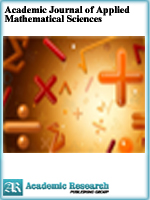Academic Journal of Applied Mathematical Sciences
Online ISSN: 2415-2188
Print ISSN: 2415-5225
Print ISSN: 2415-5225
Quarterly Published (4 Issues Per Year)

Archives
Volume 7 Number 3 July 2021
Landing Trajectory Design for UAV Considering Control Restrictions and Landing Speed
Authors: Ngo Van Toan ; Doan The Tuan ; Pham Ngoc Van ; Nguyen Thanh Tung ; Nguyen Ngoc Dien
Pages: 179-186
DOI: doi.org/10.32861/ajams.73.179.186
Abstract
The article presents a method for designing the trajectory of the UAV in space, taking into account the restriction on control. The chosen optimal controls are namely normal overload with restrictions, tangential overload with restrictions, and lateral overload. The Pontryagin maximum principle allows the transition of the optimal control problem to a boundary value problem. The parameter continuation method is applied to solve the boundary problem. The article results reveal reference trajectories in different cases of UAV landing. This result allows the design of reference trajectories for the UAV to attain the highest landing efficiency.
Auto-Transformations of the Probability Density Functions
Authors: Alexander Harin
Pages: 167-178
DOI: doi.org/10.32861/ajams.73.167.178
Abstract
The two goals of the present article are: 1) To define transformations (named here as auto-transformations) of the probability density functions (PDFs) of random variables into some similar functions having smaller sizes of their domains. 2) To research and outline basic features of these auto-transformations of PDFs. Particularly, auto-transformations from infinite to finite domains are analyzed. The goals are caused by the well-known problems of behavioral sciences.
Application of Bayesian Networks of Genotype by Environment Interaction Evaluation Under Plant Disease, Soil Types and Climate Condition-using Bayesia Lab
Authors: Siraj Osman Omer
Pages: 158-166
DOI: doi.org/10.32861/ajams.73.158.166
Abstract
Genotype by environment interaction (GEI) linked to plant disease, soil properties and climate conditions add potential value for a breeding program to underpin decision making. In understanding genotype x environment interaction, the most challenging factors are the identification of genetic variation for a range of traits and their responsiveness to the climate change factors. In order to study the complex relationships with genetic and non-genetic factors, the application of Bayesian network tools will help understand and accelerate plant breeding progress and improve the efficiency of crop production. In this study, we proposed the application of Bayesian networks (BNs) to evaluate genotype by environment interaction under plant diseases, soil type, and climate variables. An adapted to simulate multiple environmental trial (MET) data of maize (corn) was used to examine the performance of the BN predictive modeling using BayesiaLab for deriving knowledge and graphical structure for exploring GEI diagnosis and analysis. The results highlighted that genotypes have the same probability and the frequentist of rainfall, temperature, soil type, and disease type occurred as <=88 (46%), 35 (37%), clay (27%), and MB (47%) respectively, which have to monitor reflects in each discretization. This study provided a roadmap to knowledge modeling of GEI using BayesiaLab software. On a broader scale, this study helps predict the yield of crop varieties by understanding agronomic and environmental factors under farm conditions rather than conducting long-term agricultural testing under well-controlled conditions of the on-station trials. Future improvements of BNs application of METs should consider working on a larger and more detailed soil and irrigation system linked to agro system.
Stochastic Stability and Analytical Solution with Homotopy Perturbation Method of Multicompartment Non-Linear Epidemic Model with Saturated Rate
Authors: Laid Chahrazed
Pages: 149-157
DOI: doi.org/10.32861/ajams.73.149.157
Abstract
In this work, we consider a nonlinear epidemic model with a saturated incidence rate. we consider a population of size N(t) at time t, this population is divided into six subclasses, with N(t)=S(t)+I(t)+I₁(t)+I₂(t)+I₃(t)+Q(t). Where S(t), I(t), I₁(t), I₂(t), I₃(t), and Q(t) denote the sizes of the population susceptible to disease, infectious members, and quarantine members, respectively. We have made the following contributions: 1. The local stabilities of the infection-free equilibrium and endemic equilibrium are; analyzed, respectively. The stability of a disease-free equilibrium and the existence of other nontrivial equilibria can be determined by the ratio called the basic reproductive number. 2. We find the analytical solution of the nonlinear epidemic model by Homotopy perturbation method. 3. Finally the stochastic stabilities. The study of its sections are justified with theorems and demonstrations under certain conditions. In this work, we have used the different references cited in different studies in the three sections already mentioned.
Different Types of Curvature and Their Vanishing Conditions
Authors: Manisha Maheshkumar Kankarej
Pages: 143-148
DOI: doi.org/10.32861/ajams.73.143.148
Abstract
In the present paper, I studied different types of Curvature like Riemannian Curvature, Concircular Curvature, Weyl Curvature, and Projective Curvature in Quarter Symmetric non-Metric Connection in P-Sasakian manifold. A comparative study of a manifold with a Riemannian connection is done with a P-Sasakian Manifold. Conditions for vanishing for different types of curvature are also a part of the study. Some necessary properties of the Hessian operator are discussed with respect to all curvatures as well.



